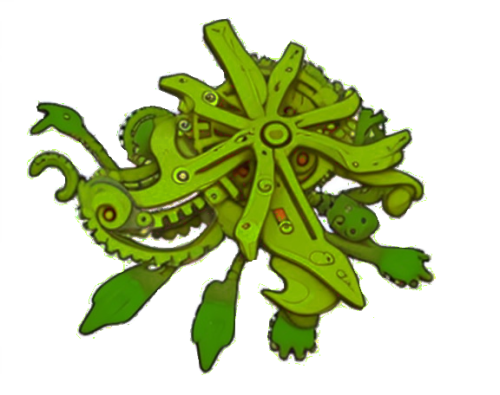BY LETTER
Plantbots
Technology > Application > Agriculture
Technology > Application > Envirotech
Technology > Technology Levels > High Tech / Hitech
Technology > Technology Type or Material > Organic/Biotech
Technology > Application > Robotics
Technology > Technology Type or Material > Syntech/Synanotech
Technology > Application > Envirotech
Technology > Technology Levels > High Tech / Hitech
Technology > Technology Type or Material > Organic/Biotech
Technology > Application > Robotics
Technology > Technology Type or Material > Syntech/Synanotech
 Image from Steve Bowers and Artbreeder AI |
Plantbots are biomimetic bots that are sessile or have extremely limited mobility, use light for an energy source, and are capable of autonomous growth and reproduction. However, most plantbots are hylonano or synano organisms. That is, they consist of largely artificial systems even if they employ some bionano technology. Fully biological organisms of artificial origin are not called plantbots but are classified as tweak or neogen plants.
Typically they are larger and more complex than mechmoss or nanoalgae, though they may live by the same processes. They are analogues of biological plants or trees. Forms designed to carry out their life cycle on a planet or moon may be anything from a few centimetres to several hundreds of metres in size, while those that live in interplanetary space, the bot equivalent of Dyson trees, may be larger yet if they can scavenge sufficient material from comets or asteroids. Typically they have large surface areas for light collection analogous to leaves, though the underlying mechanism for gathering energy is most often a nanotech photovoltaic cell rather than a photopigment such as chlorophyll. Often they mine whatever substrate they grow upon for necessary materials, using conduits analogous to roots.
Reproduction is most often by sporetech, or by "seeds" (the spore of a new plantbot plus a starter package of materials). The underlying technologies are diverse, as are the composition and physical appearance of a plantbot. Most plantbots were originally designed to colonize an environment for mining and power production and a few were originally developed for purely aesthetic reasons, but some of the more flexible neumann-capable versions have escaped and evolved on their own since they were first designed. Vecs colonizing new regions often make extensive use of plantbots. For instance, Fabers favour a suite of hardy and prolific plantbot forms. These not only produce a "fruit" that contains a standard Faber power unit, but also concentrate and that concentrate useful materials in their stem and leaf analogues.
Plantbots can be distinguished from plantvecs, which are similar in design but, like other members of the vec superphyle are capable of self awareness and are sentient and considered to be sophont or sapient. Plantbots bear more or less the same relation to plantvecs that plants bear to plant provolves. Plantvecs often resemble certain plantbots quite closely, the main difference being the increased complexity and competence of their data processing systems. Like plant provolves, plantvecs are generally more mobile than a typical plant or plantbot. Also like plant provolves they may need to be immobile or unconscious for extended periods of time, or think or move slowly all of the time, unless they live in extremely bright environments. Other sophonts that may sometimes be mistaken for plantbots are the various kinds of plant provolves, such as Seedfolk and the Alseid; however these sophonts are entirely biological in origin. Both plantvecs and plantbots typically have processors that are not biological in nature: they employ electronics, rod logic systems, or more sophisticated dry nanotech computational mechanisms.
Related Articles
Appears in Topics
Development Notes
Text by Stephen Inniss and Steve Bowers
Initially published on 15 November 2006.
Initially published on 15 November 2006.






